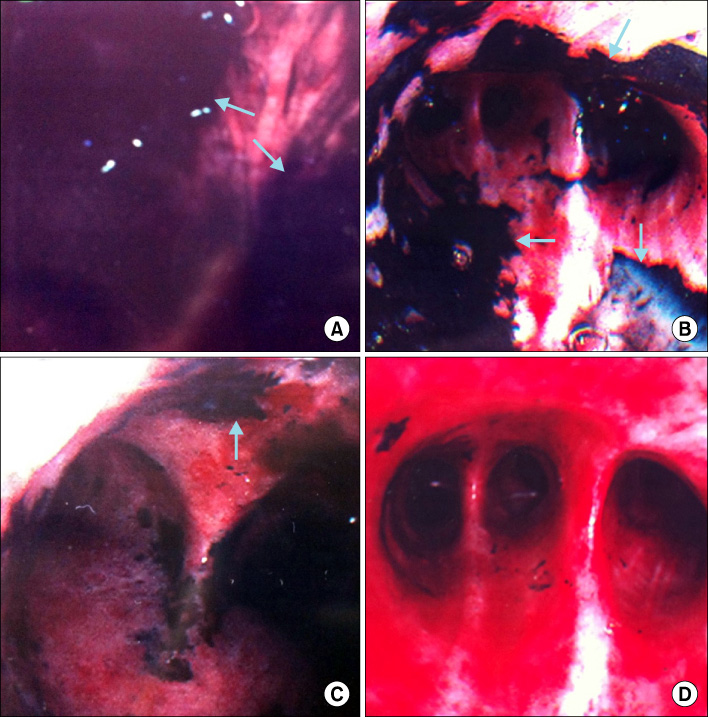Tuberc Respir Dis.
2012 Feb;72(2):177-181.
A Case of Activated Charcoal Aspiration Treated by Early and Repeated Bronchoalveolar Lavage
- Affiliations
-
- 1Department of Internal Medicine, Soonchunhyang University Cheonan Hospital, Cheonan, Korea. cjssch@schmc.ac.kr
- 2Department of Internal Medicine, Soonchunhyang University Seoul Hospital, Seoul, Korea.
Abstract
- Activated charcoal is an inert substance and it is used in standard therapy in patients with acute intoxication. Charcoal has some side effects such as pulmonary aspiration, gastrointestinal complications, and electrolyte abnormalities. Although aspiration of charcoal is a rare complication, it can cause fatal sequelae. We report a 69-year old man who developed acute respiratory failure associated with charcoal aspiration after management of glyphosate poisoning. The patient was drowsy and suffered severe vomiting during transport to our hospital. On arrival, acute respiratory failure was observed due to charcoal aspiration, but the clinical state was improved with repeated bronchoscopy with a bronchoalveolar lavage (BAL). We presumed that the aspirated charcoal was an important factor in evoking a lung injury. Early bronchoscopy with a BAL might be an effective method for eliminating charcoal from the lung, especially in the case of a large amount of aspiration, and be helpful in decreasing respiratory failure due to charcoal aspiration.
Keyword
MeSH Terms
Figure
Reference
-
1. Francis RC, Schefold JC, Bercker S, Temmesfeld-Wollbrück B, Weichert W, Spies CD, et al. Acute respiratory failure after aspiration of activated charcoal with recurrent deposition and release from an intrapulmonary cavern. Intensive Care Med. 2009. 35:360–363.2. American Academy of Clinical Toxicology. European Association of Poisons Centres and Clinical Toxicologists. Position statement and practice guidelines on the use of multi-dose activated charcoal in the treatment of acute poisoning. J Toxicol Clin Toxicol. 1999. 37:731–751.3. Elliott CG, Colby TV, Kelly TM, Hicks HG. Charcoal lung. Bronchiolitis obliterans after aspiration of activated charcoal. Chest. 1989. 96:672–674.4. Knaus WA, Draper EA, Wagner DP, Zimmerman JE. APACHE II: a severity of disease classification system. Crit Care Med. 1985. 13:818–829.5. Nam HS, Park MR, Park SY, Lim SY, Kim SA, Song JU, et al. A preliminary study on the effect of "low-dose" glucocorticoid therapy for patients with persistent acute respiratory distress syndrome. Korean J Crit Care Med. 2009. 24:80–86.6. Huber M, Pohl W, Reinisch G, Attems J, Pescosta S, Lintner F. Lung disease 35 years after aspiration of activated charcoal in combination with pulmonary lymphangioleiomyomatosis. A histological and clinicopathological study with scanning electron microscopic evaluation and element analysis. Virchows Arch. 2006. 449:225–229.7. Seder DB, Christman RA, Quinn MO, Knauft ME. A 45-year-old man with a lung mass and history of charcoal aspiration. Respir Care. 2006. 51:1251–1254.8. Kim S, Kang NR, Sohn I, Lee H, Lee YK, Song SH. Acute respiratory distress syndrome with chemical pneumonitis after aspiration of activated charcoal: a case report. Korean J Crit Care Med. 2010. 25:112–117.9. Roberts DM, Buckley NA, Mohamed F, Eddleston M, Goldstein DA, Mehrsheikh A, et al. A prospective observational study of the clinical toxicology of glyphosate-containing herbicides in adults with acute self-poisoning. Clin Toxicol (Phila). 2010. 48:129–136.10. Harris CR, Filandrinos D. Accidental administration of activated charcoal into the lung: aspiration by proxy. Ann Emerg Med. 1993. 22:1470–1473.11. Golej J, Boigner H, Burda G, Hermon M, Trittenwein G. Severe respiratory failure following charcoal application in a toddler. Resuscitation. 2001. 49:315–318.
- Full Text Links
- Actions
-
Cited
- CITED
-
- Close
- Share
- Similar articles
-
- Five Successful Experiences in the Treatment of Charcoal Aspiration with Bronchoscopic Toilet: A Case Report
- Acute Respiratory Distress Syndrome with Chemical Pneumonitis after Aspiration of Activated Charcoal: A Case Report
- Changes of the cellularities in the bronchoalveolar lavage fluid of the experimental silicosis
- A Case of Aspiration Pneumonia with Acute Respiratory Distress Syndrome Following Aspiration of Polyethylene Glycol Solution Treated by Bronchoalveolar Lavage
- Relevance of Measuring Substances in Bronchoalveolar Lavage Fluid for Detecting Aspiration-associated Extraesophageal Reflux Disease



